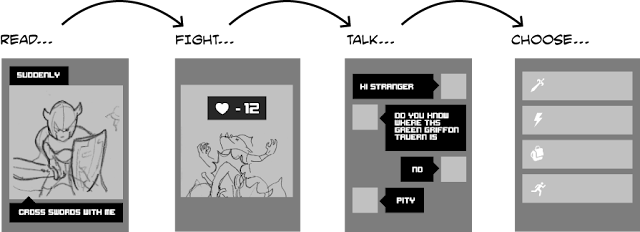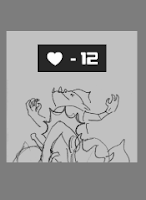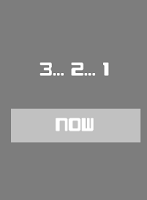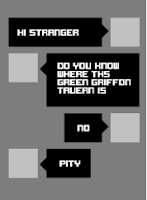 Mysterious Path will switch between several modes of play
Mysterious Path will switch between several modes of playPlaying the Mysterious Path hypercomic will involve more than just navigating a path through the adventures branching plot lines. While making 'dramatic' choices is likely to be the primary focus of the Mysterious Path experience there will be several other play modes. Including modes enabling you to fight battles, converse with NPCs and a play a selection of skill based mini-games.
NB: I am still contemplating how (and if) I should include any game elements as they could be seen as an obstacle/distraction to the story. I am hoping game elements will enhance the core experience, by changing the pace and adding tension, where success or failure will lead to interesting consequences for the player. One gamebook enthusiast has identified a difference in purely narrative focused interactive fiction and ones that are fused with game elements - I think I'd like to blur this binary distinction a little.
My design challenge will be to get these disparate modes to gel seamlessly together. Ok, so what are these play modes...
1) Panel flow - The comic reading bit.
2) Fight flow - The fighting bit.
5) Mini games - Collection of assorted skill tests (strength, speed, memory)
4) Dialogue - Interactive conversations with other game characters.
5) Menus - Invoking and navigating menu items (inventory, spells, clues)
6) Game over - End mode... what happens next?
Players will switch play modes by: making a choice (or series of choices) or it will be determined by the success or failure of another interactive mode (a fight, conversation or skill check)
Example of mode switching below...
1. Panel flow
Panel Flow will be primary mode of Mysterious Path. This is where the comic will be presented to the user to consume. This mode will probably require the most design iteration to get right as it presents many interesting design challenges...Should the comic be responsive and morph to fit on various device sizes (mobile, tablet, desktop)? Should I design for the small screen first? Or are times changing (tablet first!?)
How will the presentation change in portrait or landscape mode? Should I choose fixed view? If so, which screen orientation works best!?
How will the user flick between panels: scrolling, swiping or clicking through? Are pages a dead concept? If so how will I cluster sequences of related panels? Where do I put all those speech bubbles and captions? And, most importantly, what new experiences (afforded by a digital format) will enhance the reading experience?
I have performed a little research on the question of digital comic presentation but will follow up with a post on my proposed 'solution.
2. Fight flow

When a player engages in combat with another game character he enters the Fight Flow mode. This mode should feel more dramatic and tense than Panel Flow mode, visually it needs to represent a step up in gear.
I have still yet to decide on the exact combat mechanics for the game. Should combat be turn based or real-time? Should fights be based on strategic decisions or skill based tests? How will stats be displayed? What about special attacks or weapons? Should I minimise/remove luck as factor in determining the outcome of a battle? Shouldn't the player should feel as though they lost a fight due to a lack of skill or poor strategic decisions, rather than robbed by an unfortunate die roll?
I've even contemplated a simplistic scissor, paper, stone combat mechanic, which I don't think is as daft as it sounds (Other gamebookers kinda agree). Look out for other combat explorations in subsequent posts.
3. Mini games
 The Mini Game mode will fulfill the role of the skill/luck tests in the original Fighting Fantasy books to create a win/lose outcome that does not involve combat.
The Mini Game mode will fulfill the role of the skill/luck tests in the original Fighting Fantasy books to create a win/lose outcome that does not involve combat.Again, rather than use dice, I plan to present a mini game experience that is suitable for the in-game challenge (e.g a reaction test to avoid a surprise attack, or a memory challenge to cast a spell)
Will these real time events break the comic conceit of read at your own pace? I don't want to create a videogame, animation or multimedia experience. I want to remain true to the comics core principles. You effectively watch Tell Tales Game's Walking Dead. Choices are timed (which creates tension and panic) but non-interaction is an option too! You can sit back and watch the outcome. They use time consistently throughout the experience and have created a great, narrative focused game. In an earlier post I describe how motion comics 'play' the story to you and become an impoverished form of animation, no longer using the principles sequential art.
So the jury's out on how/if I should include real time components... although they have definitely been used effectively by other designer/developers. I'm not sure they have a place in Mysterious Path. I do plan on giving it a try though!
4. Dialogue
 Meaningful relationships with non-player characters (NPC) were always clumsily handled in early gamebook, interactions with them were very limited and, as result, these stories failed to tap into the potential a supporting cast of characters could offer an interactive story. Enabling a mode were you can converse with NPCs (seek their advice, their support and approval) is a great way to foster emotional bonds and get the player to care more about the consequences of their actions.
Meaningful relationships with non-player characters (NPC) were always clumsily handled in early gamebook, interactions with them were very limited and, as result, these stories failed to tap into the potential a supporting cast of characters could offer an interactive story. Enabling a mode were you can converse with NPCs (seek their advice, their support and approval) is a great way to foster emotional bonds and get the player to care more about the consequences of their actions. With this mode, rather than following strict comic conventions, I will attempt to inject some of the personality from my other source of inspiration, 8bit RPGs and maybe adopt a chat style interaction model.
This format would be great on small screen, but would it scale to larger screens? Will it jar the comic format of panel flow? Will little avatar icons be able to help convey emotions? Again one to experiment with.
5. Menus
 Accessing and navigating menus will need to be simple and elegant, allowing player to access and manage their
inventory, spells and other collected information without fuss.
Accessing and navigating menus will need to be simple and elegant, allowing player to access and manage their
inventory, spells and other collected information without fuss.A menu may be evoked at particular juncture in the game or at anytime on user command.
Aesthetic inspiration for the menu system will be drawn from old school 8bit RPGs, but may also employ some of the conventions of card/boardgames.
The larger design task here will be to develop a global navigation for starting/continuing multiple games, tracking different paths and scores and, maybe one day, for downloading expansion packs.
6. Game over
 Not really a mode of play... but end game does raise a lot of interesting questions.
Not really a mode of play... but end game does raise a lot of interesting questions.What happens when a characters dies? Do they have a limited lives lives? Can they earn more lives? Would being resurrected too many times deny them the true ending? Can they easily retrace their steps and try another branch? Does the game have saved points? Could collecting interesting death scenes be an interesting mini achievement to encourage replay? Should players be allowed to die at all? Without fear of death will there be any risk/engagement? Could failure be about narrative resolution rather than death of the character?
Others have discussed death in interactive fiction. My current view is that bad luck should not be a factor in whether you can complete a Mysterious Path adventure, after all who didn't fudge dice rolls when playing Warlock of Firetop Mountain. Surely there must be a prevailing sense of danger to help keep the player challenged/focused. A delicate balance of exploring the dramatic possibilities and risk/reward gameplay is the ambition.
Other ideas
I have other ideas (e.g hex maps, dungeon maps...) but, hopefully, if the overall architecture is designed correctly, adding a new mode of play later shouldn't be a massive problem. I'd love to hear any thoughts you guys have on the concepts discussed here or any additional modes you think would be interesting...Further reading
Learning from webcomics, motion comics & infinite canvas
 Reading comics on digital platforms has been approached in various
ways, which solutions will provide design insight for Mysterious Path?
Reading comics on digital platforms has been approached in various
ways, which solutions will provide design insight for Mysterious Path?


I am really looking forward to this comic. I like the way you have brought together a lot of elements to appeal to everyone and to make sure that the consequences of the game are based on strategy and decisions rather than luck. It will definitely make the player feel more in control.
ReplyDeleteI worried about having too many elements! Do I need to be more like Gordon Ramsay and focus on fewer, but better quality, ingredients?
DeletePS Looking forward to your Tin Man production (as I enjoyed the Call of Khalris... though I cheated and never keep a journal!)
Many thanks. I'm glad that you enjoyed call of Khalris and it is kind of pertinent to this post. I think I was trying to do too much with it and as Brewin' pointed out in his review, I was asking the player to play the game in diffferent ways - rate themselves as a character, then as a player. Most players would not have wanted to both keep a journal and a cheat score as they focused on aspects of the game that were very different. So I guess if you have lots of in depth combat AND interaction it may alienate the players that want both.
DeleteMy gut feeling (and this may be just me) is that since it is a comic, the world will feel more alive than just using text and that format will probably lend itself more to players who want to immerse themselves in a world and role play more than number cruncher types.
So many questions. Is indecision killing you yet?
ReplyDeleteI find the answers are "arrived at" by first setting up core values. For example, suppose you set a rigid rule that players will never have to repeat content. This would eliminate some of your Game Over questions.
Also, limitations of the medium can make the decisions for you. If it takes too long to produce drawings and you have monthly deadlines, this kind of answers how much replayability your games can have, doesn't it?
Your target audience will further eliminate possibilities. Suppose you had a standard: "These games are even playable for the physically challenged." Poof--this answers whether you should have reaction speed tests (no). If your work is for all ages, this settles the question of gore or no gore.
For each "mode", decide exactly what your audience should feel. This will also narrow down the possibilities. Don't scoop all of them like "risk/engagement", "challenged/focused", "dramatic and tense". Maybe you don't need to hit all of these. Set precise goals instead of an uncontrolled mishmash. Pick one emotion that your systems *must* evoke, and start from there.
Format and aesthetics: an open beta test should help with this.
Combat: readers are lazy, and rightfully so because reading is active work. So minimize tasks and tedium. I often want to skip battles in interactive fiction. Don't let it happen in yours.
Mini games: I'm just one man, but I wouldn't like jumping out of the medium as with the reaction test. Maybe a test can ask about details the player noticed in the background art many panels ago that may not have even been there or are randomized or are randomly placed into panels. That way, we stay in the comic world. Example: "I need a four-pronged herb. Hmm...where did I last see one of those?" [It appeared in one of four panels]
You also can't go wrong with riddles or world lore. IQ tests have categories worth researching like vocabulary, spatial reasoning, etc, that might be fun.
Hope that helps!
Sage words Nicholas.
DeleteIndeed I am suffering from analysis paralysis. It's part of the the reason I dumped my angst in this post, just to get it out of my head.
Comics (and books) are a passive, linear form of entertainment. Videogames are real-time and active. I had hoped that the two forms could be assimilated to create a new experience but they seem to be reluctant to fuse together.
I like my videogames to be sandboxes with immediate feedback to my actions, or to be able to wander through another world. I hate sitting though cut scenes (no matter how high the production values!) Games are not movies.
In my linear fiction I like the story/characters to take the most interesting and dramatic paths. I don't want to co-author them, I just want to be told a good yarn and taken on a journey. Books are not interactive.
At the moment, the two forms seem impossible to reconcile and it feels like I should be simply making a 'better' digital comic. This certainly feels like a safer way to proceed.
...but there is a niggling feeling that I should be exploring the creative opportunity interactivity brings (although I am heavily critical of interactivity for interactivity's sake)
In my day job I spend my time trying to boil things down to their essence. To identify the core function and execute it to highest standard, without distraction. To avoid feature creep, or attempts to please all the people all of the time which, I know, dilutes product focus and differentiation.
I can certainly be accused of throwing together too many unstructured ideas, although I'm at the messy part of the creative process. However I think your idea of abstracting design decisions to a higher set of principles is insightful and will be a useful developmental tool.
The next step is to develop Panel Flow mode. It maybe this is the only mode I use in the end. Even if I only succeed in creating an interesting way of reading digital comics I will be satisfied.
Thanks again for your thoughtful response, it's definitely focused my mind.
I think Nicholas has some great points, but I also definitely appreciate that there's value to throwing a bunch of ideas out there at a certain phase. Early on in the development process, it makes sense to forget the word "no" and just toss out all the awesome ideas you can think of. Later, you can trim and cut and hone.
ReplyDeleteThe main thing I want to say, after reading through the ideas you've presented here, is that there's no right answer. You sound like you're trying very hard to make the perfect comic-game-thing, but what are you going to do with it once it's done, even if you do make the absolute perfect game? It could be the most perfect game everybody has ever played, and everybody will love it, and then 6 months later they'll have played it and want something new.
Creative endeavor is never about making "perfect," it's about taking the next step in the ongoing evolution of a genre. And you're well on your way to doing that, just with your core ideas here.
Relax. Remember to have fun. Pick something that you think is cool, and develop that first. Then decide what feature will be the best to add next. You can always make another game later that takes a different approach.
I think of making a game as being a little experimental. You push it out there and say, "Let's see how this idea does." It helps me to think of it, not as my baby, but just as one more iteration, one more statement in the ongoing dialogue about games and how we play them (albeit hopefully a new and exciting statement that will add to the conversation ;)
I think you're already bouncing around some great ideas, and I'm very excited to see where this is going. I said there's no one right answer, well, there are wrong answers, but I don't see any of them here. Just a bunch of right answers. How you put them together will be pretty exciting :)
Perfection is certainly a killer... my self imposed weeklish blog post is designed to force me to write, draw and publish. I need to get comfortable with pushing out less than perfect material and just get it done (this still pains me). So against my nature I am trying to publish and be damned! I have found transparent, analytical blogs by content creators (gamebookers, comic artists & indie game designers) a great source of motivation and was moved to do something similar with Mysterious Path.
DeleteI also agree with you about design iteration. I've always meant to release small interactive experiments 'often and early' to validate concepts and solicit feedback, hence my prototype tab (which is prophetically empty!)
In terms of personal project vs. business venture, Mysterious Path is certainly the former at the moment. However, I'd also presumed that my hypercomic creation tools could be 'productionised' for the broader webcomic community (a bit like Twine or Inkle does for interactive fiction) or maybe form a collective of content creators similar to your Black Hat Writing.
PS... also enjoyed Zendari. I love the idea of choices being influenced by an overarching time limit but required a lot of effort from lazy readers like me. Time tracking is something a digital format would be perfect for.